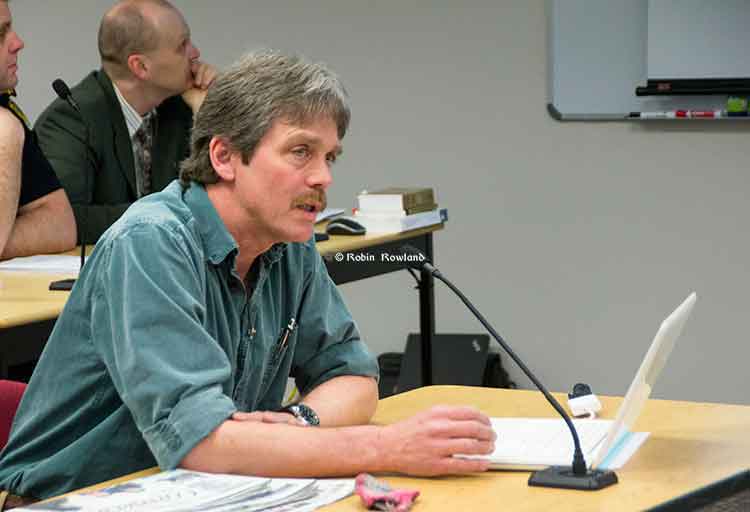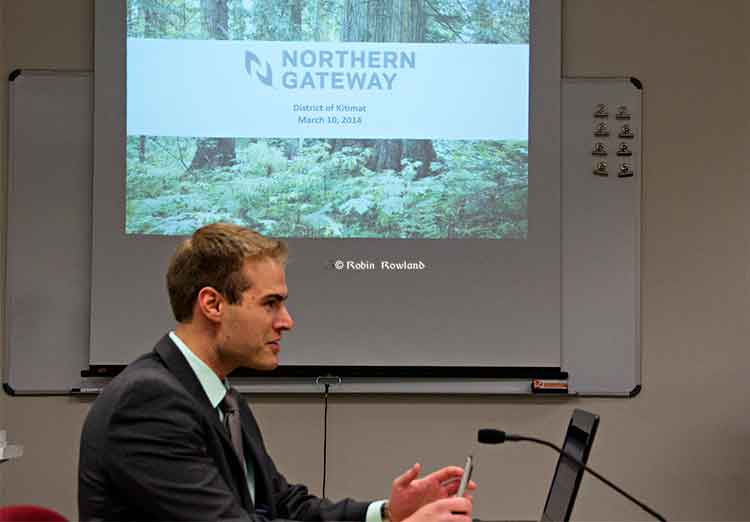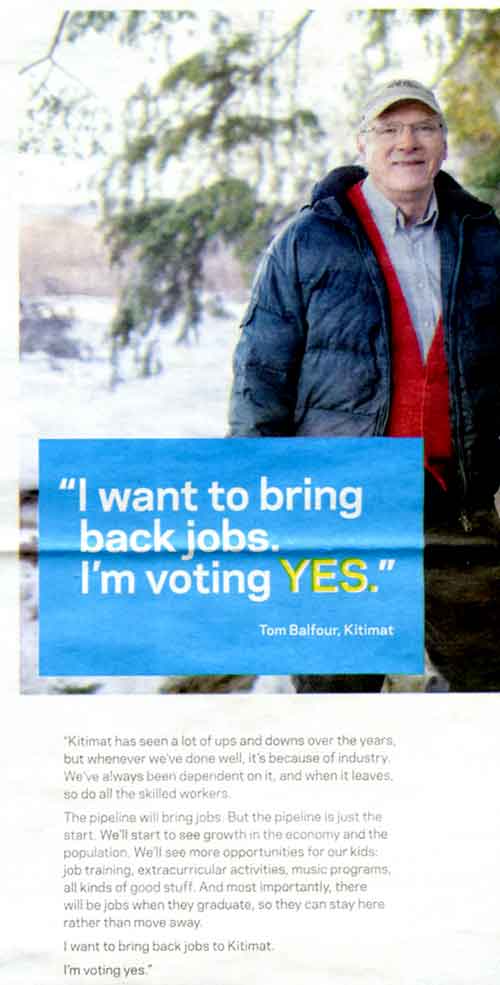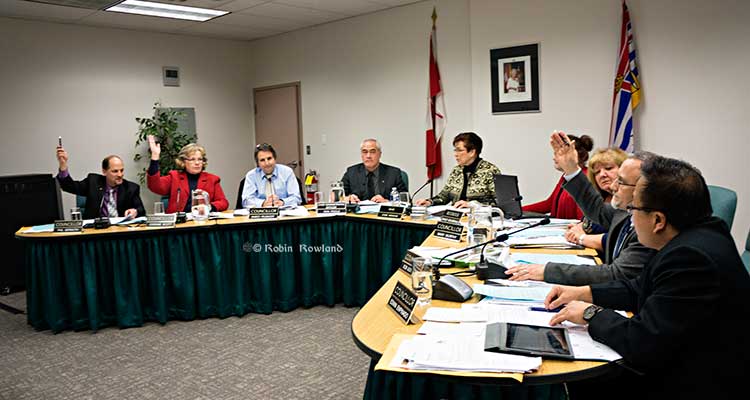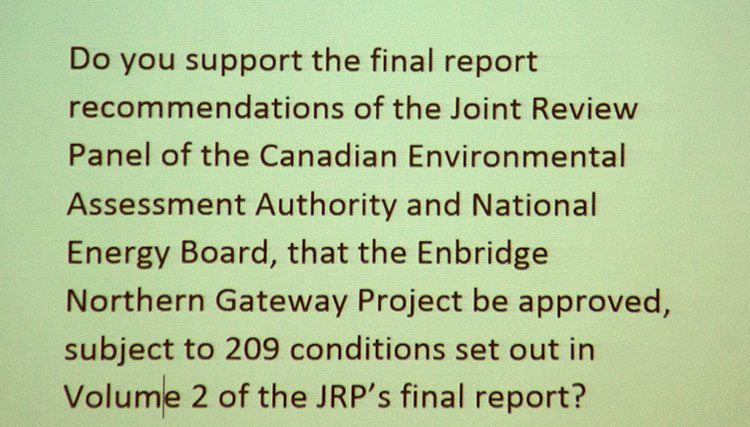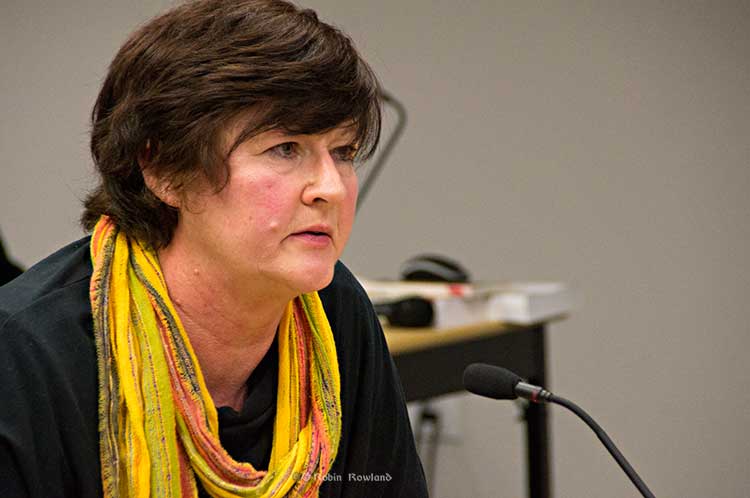
A high turnout is expected Saturday for the non-binding plebiscite where residents of the District of Kitimat can, perhaps, say yes or no to the Enbridge Northern Gateway project. In some ways, it all depends on how people interpret the convoluted question.
Warren Weychasen, Kitimat’s Deputy Administrative Officer said Thursday 910 people voted during advance polls on April 2 and April 9, compared to 470 over the two days of advance voting in the 2011 municipal election.
Even who can vote has can be the matter of heated debate. Members of the Haisla Nation who live in Kitamaat Village feel strongly that they should have a voice, even though legally they live outside the municipal boundaries. “It’s our land they’re talking about,” one Haisla member, who wouldn’t give his name, said Friday as he was getting off the Village bus at City Centre.
The District also decided to allow residents of Kitimat who have been here longer than 30 days to vote, even if they are not Canadian citizens.
Another group that can’t vote, many from outside the northwest region, are living at the Rio Tinto Alcan Kitimat Modernization Camp or at smaller camps for the developing LNG projects. An informal poll of those workers at City Centre Friday showed that if camp workers had been allowed to cast a vote, many would have voted “yes,” something the opponents of Northern Gateway said they feared would overwhelm local residents.
The $6.5 billion project would see two pipelines, one carrying oil sands bitumen from Alberta to the port of Kitimat, and a second carrying a form of natural gas used to dilute the bitumen from Kitimat to Alberta. The bitumen would then be loaded onto tankers for shipment to Asia along environmentally sensitive areas of the British Columbia coast.

Northern Gateway’s campaign has concentrated on the promise of 180 permanent direct local jobs worth $17 million and more spinoff jobs for contractors and suppliers. The company also promises that the District will receive $5 million in property taxes.
Northern Gateway also emphasized its commitment to safety and the environment, saying that the National Energy Board Joint Review Panel that held two years of hearings on the project, has made many of the company’s voluntary commitments a mandatory part of the conditions for granting permission to go ahead.
The main opponent, Douglas Channel Watch, maintains that the risk from either a tanker accident or pipeline breach is too high for the small number of jobs Northern Gateway will bring to the community.
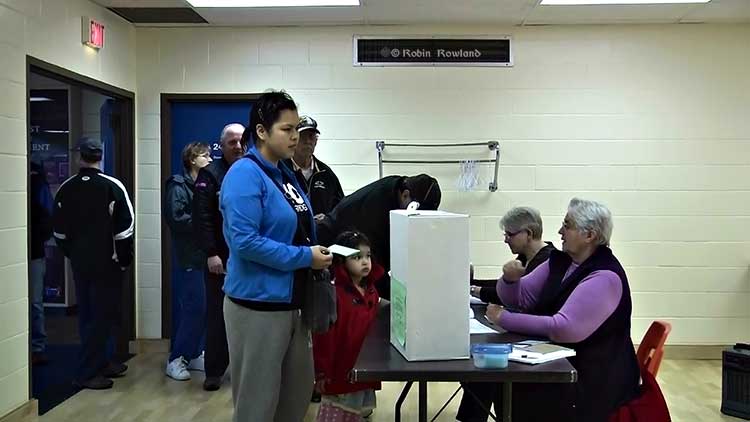
Controversial question
Even the question, as chosen by the District of Kitimat Council, is controversial, because it focuses on the 209 conditions placed on the project by the Joint Review Panel:
Do you support the final report recommendations of the Joint Review Panel (JRP) of the Canadian Environmental Assessment Agency and National Energy Board, that the Enbridge Northern Gateway project be approved, subject to 209 conditions set out in Volume 2 of the JRP’s final report?
After the district council decided on that question, debate on the wording continued through several council sessions in January and February.
Public delegations, some from Douglas Channel Watch, told council that there should be a simple yes or no question.
On January 13, Donny van Dyk, Northern Gateway’s local manager for coastal aboriginal and community relations, told council that the company preferred a series of simple questions, because “We avoid an adversarial feeling plebiscite and we generate dialogue and debate amongst the plebiscite but also so we as a proponent can come away with value and create a better project.”
Council rejected a proposal for a series of simple of questions, leaving voters to decide on whether or not they supported the Joint Review recommendations. That raised the question of whether voters would make their choice on some of the provisions of the report and not the project itself.
What does it mean?
That means that even Council is unsure of what the vote will mean.
The main reason for holding the non-binding plebiscite is that it fulfills a promise from an all candidates meeting during the municipal election in November 2011, where every candidate agreed to “poll” the citizens of Kitimat on Northern Gateway.
After the new council took office, on Jan. 16, 2012, it voted to hold some sort of poll or vote to find out whether the community supports the Enbridge Northern Gateway pipeline project. At the time, it was unclear after the vote how the survey would take place.
For the almost two years of the Joint Review Panel, the District of Kitimat did little more than act as spectators when the JRP was in town, claiming its neutrality policy precluded participation.
The District could have participated without violating the neutrality provisions, but chose not to do so. It’s now clear that decision angered the Haisla Nation, as Chief Counsellor Ellis Ross said in a letter to the media, “the District stood by and did nothing”
The debate in the District of Kitimat Council on March 3 showed that even members of council were uncertain what the vote would mean.
Councillor Corinne Scott said, “As much as we wanted to know what the feeling of the community is, all we know so far is that we’re split. What the percentage of split is, we don’t know,” said Scott.
Councillor Phil Germuth said the vote is not on the project itself, but on the Joint Review decision. “We’re asking about 209 conditions that nobody understands fully. Even Enbridge doesn’t fully understand them.”
Councillor Edwin Empinado said once the results are known, that would give the District “more bargaining power” in future dealing with company and the federal government, a sentiment echoed by Douglas Channel Watch which admits the vote will do little more than send a message to Ottawa.
It was Northern Gateway’s decision to put major resources into the campaign that raised the profile of what was originally intended as way of discovering the feeling in the small community. With the ruling from the Joint Review Panel that Northern Gateway is in the national interest and the final decision in the hands of the federal cabinet, it is equally uncertain what effect, if any, the vote will have on Ottawa.
Acrimonious debate
Throughout the hearings, most people in Kitimat kept their views to themselves. When the campaign began in earnest, which in turn, triggered a fierce and often acrimonious debate on social media, mainly on the Facebook group Kitimat Politics, showing the divide in the community, although it appears from the comments that there are more opponents than supporters on the forum. The e-debate on Kitimat Politics is continuing up to the last minute Friday night and will likely get hotter once the results are known.
The adversarial feeling that van Dyk had said the company wanted to avoid was amplified in the past month when Northern Gateway began an aggressive public relations campaign with newspaper ads, glossy brochures and a door-to-door campaign by employees, some brought in from Alberta.
When news of Northern Gateway’s campaign effort spread on social media, which in turn prompted a counter campaign using the hashtag #adsforkitimat. Ads created by people from across BC were posted on Facebook and YouTube.

Campaign spending
Douglas Channel Watch positioned itself as the David vs. the Enbridge Goliath.
On Monday, Murray Minchin of Douglas Channel Watch told Council, “When Kitimat and northern BC residents found out how many resources Enbridge was pouring into their Kitimat plebiscite advertising campaign, some of those citizens made unsolicited donations to Douglas Channel Watch. This has allowed our small group to mount an advertising campaign of our own.” Minchin said donations went up after the group launched a website adding, “People began handing us money on the street while we were putting up lawn signs. Somebody, anonymously, left a $2,000 money order in one of our member’s mailboxes.
On Thursday, Douglas Channel Watch released its advertising budget showing that the organization spent $10,970.00 on print media ads, $792.92 on supplies, and has an outstanding debt of approximately $2,600.00 in radio ads, for a total of $14,362.92. Minchin challenged Enbridge to release its own ad budget.
Ivan Giesbrecht, a spokesperson for Northern Gateway said in an e-mail to the media that the company “will discuss our advertising spending after it’s over [the plebiscite] this weekend.” Late Friday, Giesbrecht released partial figures to the Northern Sentinel, saying the company had spent $6,500 in print and $3,100 on radio advertisements during the campaign.
Those figures don’t include the glossy brochures Northern Gateway distributed in the community, sponsored posts on Facebook, or the signs the dot the streets of Kitimat.
Douglas Channel Watch did put up signs. Many were recycled from earlier protests, came from Friends of the Wild Salmon or were created by volunteers from as far away as Smithers.
Giesbrecht told the Sentinel said the company felt that the discussion in the community about which side of the vote has spent more had “become a distraction” from the real issues. But instead of a discussion on jobs and taxes, on Friday night there was a raging debate on Kitimat Politics on Facebook about the Gateway release on its spending and what was missing from those figures.
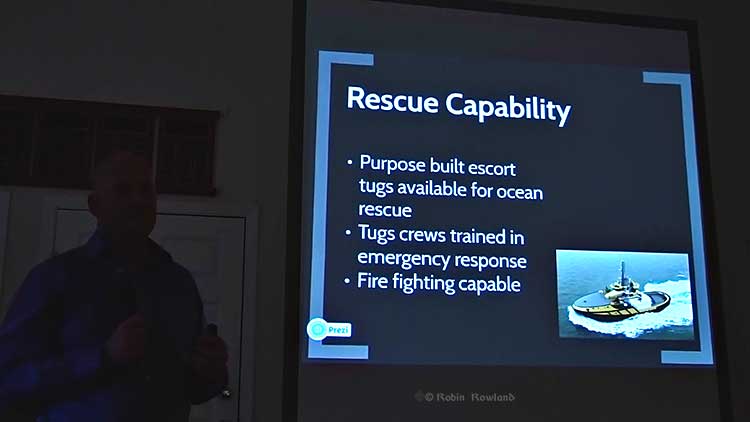
Super tugs
On a cold and rainy Tuesday afternoon, Northern Gateway hosted an Open House and barbeque at the Rod and Gun. Northern Gateway not only outlined the jobs they say the project would create, but emphasized how far along the company is coming in meeting BC Premier Christy Clark’s condition for a “world-class” tanker spill prevention and response system.
Janet Holder, Enbridge Vice President of Western Access described what she and Northern Gateway staff called “super tugs,” 50 metres long. “One will be tethered to the tanker, one will be following the tanker,” Holder said. “So there will be two escorts whenever that tanker is in Canadian waters. The important thing about the tugs is not just they can move that tanker if it get into difficulty. It also contains emergency response equipment right with the tankers. We’ll also have strategically placed barges with emergency response equipment along the shorelines. We will be bringing in an enormous amount of equipment before we even start operating.”
Owen McHugh, a Northern Gateway emergency manager said, “Adding these four or five tugs to the north coast provides a rescue capability that doesn’t exist in this format. So for any large commercial vessel that is traveling on our coast, this capacity to protect the waters of the north coast.” The tugs will also have firefighting capability. “The salvage capability that BC describes as ‘world-class,’ Northern Gateway is bringing that to the north coast,” McHugh said.
The plebiscite has raised tensions between the District of Kitimat and the nearby Haisla First Nation, which adamantly opposed to Northern Gateway.
Haisla anger
Haisla chief counsellor Ellis Ross wrote a scathing letter to local media, saying, in part:
Deciding to hold a referendum at this late date is a slap in the face to all the work done by the Haisla Nation on this project. The Haisla Nation dedicated time and money toward testing Northern Gateway’s evidence and claims about safety and environmental protection, while the District stood by and did nothing.
The review process for this project has already left town, with the District taking no position on the project. Still undecided on what its views are on the project, the District now proposes to conduct a poll, instead of examining the facts in the JRP process. A poll to vote on a JRP report that we view as wrong to begin with including the flawed process itself!
On Sunday, the Haisla Senior Women were playing the Prince Rupert Thunder in finals of the annual Kitimat Open Basketball Tournament which has the aim of promoting “Cultural Warming” among everyone living in northwestern BC. At half time, members of the Haisla Nation distributed black T-shirts labelled with “No Enbridge” to spectators in the bleachers. After the Haisla won the game, 67 to 45, as Kitimat mayor Joanne Monaghan was called on to congratulate the winners, she was greeted by chants of “No Enbridge, No Enbridge.”
At Tuesday’s Open House, one of the audience asked Enbridge officials, including Janet Holder, “Why are you ignoring the Haisla?”
Donny van Dyke responded, “We are actively working to strengthen that relationship….” Then when the questioner persisted, van Dyke said, “With this question perhaps it’s better to take it offline.” Then he asked, “Are there any other questions?”
Special meeting
Monaghan has said the council will wait for the outcome before taking a stand. District Council has called a special meeting on Monday night to consider the results of the plebiscite.
For years the District of Kitimat has been officially neutral but voting over the past years shows that council is evenly split on Enbridge issues with swing votes sometimes going one way and sometimes another on what are often four to three votes.
The federal cabinet has until mid-June, 180 days after the release of the Joint Review decision to approve the panel’s findings. It is expected by most observers that Prime Minister Stephen Harper will give the go ahead. That doesn’t mean the project will start immediately, the Joint Review findings already face about a dozen court challenges from First Nations and environmental groups.
Minchin said Saturday’s non-binding plebiscite “is not going to affect the Prime Minister’s decision per se. But it’s very important for Enbridge to squeak out a win here in Kitimat. It’s just my feeling that this proposal is associated with way too many risks for very little gain.
“If it comes back as a ‘no’ from Kitimat, it’s a clear signal back to Ottawa that they really need to rethink their priorities. For the amount of bitumen that would be coming here and exported as a raw product’ that same amount of bitumen would provide a couple of thousand direct jobs in Alberta. It seems crazy to be shipping off all our raw resources without any upgrading, it’s like raw log exports.”
Enbridge Vice President Janet Holder, speaking at the Open House said, “This is not a pie in the sky type project, it is real, we do have the shippers behind us, we have First Nations behind us.”
Outreach continues
No matter what happens Saturday, both sides will continue to push their positions.
Holder said she would not speculate on the outcome of the plebiscite, “We’re going to communities throughout British Columbia, talking to citizens, providing the information, listening to their concerns. We’re just continuing with that outreach and we’ll continue with that outreach over the next year.”
How Kitimat voters cast their ballots depends on factors that go beyond the simple environment versus economy and jobs argument, so the outcome of Saturday’s plebiscite is far from certain.
In 2010, West Fraser’s Eurocan paper mill closed, with the loss of 500 jobs, a devastating blow to Kitimat’s economy. The Eurocan closure, the earlier closure of a Methanex plant and cutbacks at the Rio Tinto Alcan smelter and the abandonment of mills and mine across the northwest in recent years have left many people skeptical of corporate promises of jobs. Others believe the Northern Gateway project, along with proposed Liquefied Natural Gas projects in Kitimat and Prince Rupert will bring a much needed boost to a struggling economy.
Even though Kitimat has been an industrial town since the aluminum smelter was built in the 1950s, most residents fish in the Kitimat River, boat on Douglas Channel and hike or hunt in the back country, which means environmental concerns are always high on the agenda. There are fears even among some supporters of Northern Gateway of an environmental disaster.
Northern Gateway, which has admitted that its relations with northern communities started off badly in the early stages of the project, has a lot of catching up to do, no matter what the outcome of the plebiscite.
Nathan Cullen, NDP MP for Skeena Bulkley Valley and Opposition Finance Critic came to Kitimat last week to assist Douglas Channel Watch with its door-to-door campaign. “There will be PhDs written on how Enbridge blundered this,” Cullen told reporters at the time.
(Spelling of van Dyk was corrected. We regret the error)



